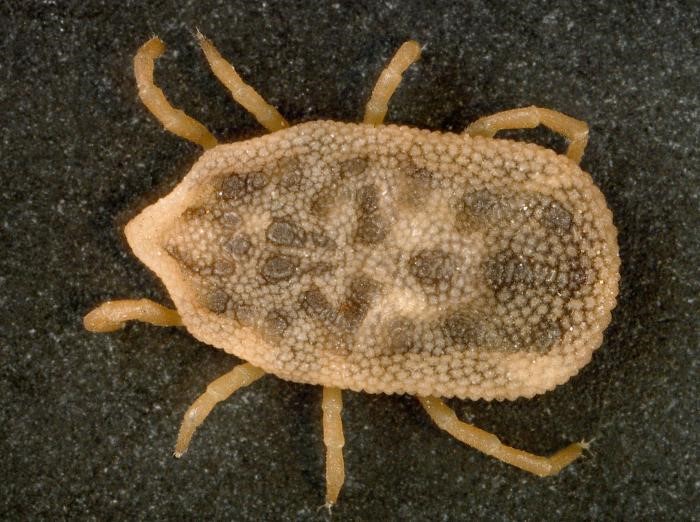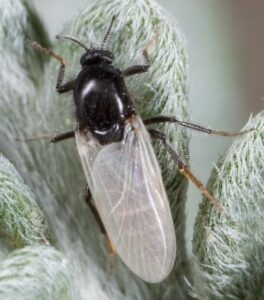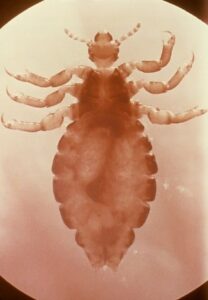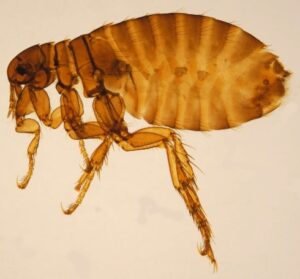Ticks are the largest group of non-insect parasites of vertebrates. It ranks second after mosquitoes in transmitting diseases to humans. Ticks are not insects, they are arachnids. This order contains two important groups: ticks and mites. The life cycle goes through three main stages: eggs, larvae (with six legs), and adults (with eight legs).
Ticks have two body parts: the cephalothorax (combined head and thorax part) and the abdomen. Insects have three body parts: the head, thorax, and abdomen. Ticks have eight legs and insects have six legs. Ticks eyes and eight legs are located on the cephalothorax. Insects have their eyes on their head and their six legs are located on the thorax. Ticks do not have wings or antennae like insects usually have.
All types of ticks parasitize during a period of their lives, and all species have the characteristic of choosing a host, whether it is from mammals, birds, or reptiles. The adult stage may be present in one organism while the larval stage may be present in a different organism. Intrusion in this way leads to the expansion of the spread of the microbe and thus the increase in the spread of diseases.
Ticks, which are of health importance, belong to two families: Hard Ticks (Family Ixodidae) and Soft Ticks (Family Argaside). Ticks transmit many dangerous diseases to humans, such as a recurrent fever that occurs in the tropics, Texas fever, typhus fever (Rocky Mountain fever), red water fever, and yellow fever, all of which are diseases that originally affect animals, and humans become infected with them accidentally due to infectious tick bites.
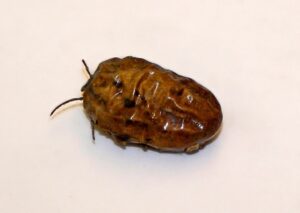
Hard Tick (Ixodidae) Credit: Hectonichus |
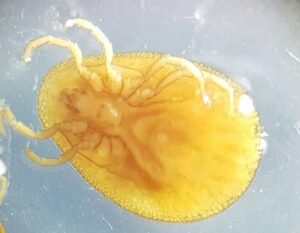
Soft Tick (Argaside) Credit: Navid drogba |
Since ticks are long-lived animals (the life cycle in some species may last 5 years) and have a high ability to reproduce (some species lay nearly 15,000 eggs), they are of great health importance. In addition, there is no specialization in ticks that transmit a particular type of disease. Some species transmit several diseases, and sometimes several types of ticks transmit one disease. Ticks have the ability to reproduce virginally (without mating), in addition to the ability to replace lost or amputated parts such as legs and mouth parts.
The tick sticks tightly to its host during feeding and does not leave it easily, and its bite causes severe pain to the host, and this is accompanied by anxiety and restless and interrupted sleep.
ETS-trained professionals have the ability to identify different species of ticks that infest livestock and offer solutions and recommendations to control ticks and prevent future infestation.
Various hard and soft ticks are found in UAE. The common species are:
I – Hard Ticks: (Family Ixodidae: Order Parasiformes)
1. Brown Dog Tick – Rhipicephalus sanguineus (Latereille) (Ixodidae)
- Camel Tick – Hyalomma dromedarii Koch
II – Soft Ticks: (Family Argasidae: Order Parasiformes)
- Fowl Tick or Poultry Tick – Argas persicus (Oken)
- Relapsing Fever Tick – Omithodorus turicata (Douges)
I – Hard Ticks Small or minute animals, and males are smaller than females, which reach a length of several centimeters when their bodies are filled with blood. The animal has an external skeleton consisting of all or part of a hard chitinous covering called the shield. The shield covers the entire body in the case of males. In females, this shield is limited to a small part in the front of the body and may be mottled in color. The mouth parts extend in front of the shield so that they can be seen clearly, and there are sharp hooks on them, the pointed end of which goes to the back, so that if it enters the skin of the host, it does not come out easily. If the eyes are found, they are on both sides above the shield. The body wall is mostly smooth, with ridges on the dorsal surface at the end of the body. The most important genera of hard ticks are Hyalomma, Rhicicephalns, Ixodes, and Boophilus. The life cycle of the hard tick varies according to the number of hosts to which it is attached.
- Brown Dog Tick:
General Description
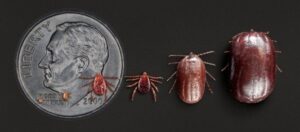
- Eggs of the brown dog tick are spherical and dark brown in color.
- Larvae have three pairs of legs with a body size of approximately 0.5 mm in length and 0.4 mm in width.
- Nymphs and adults have four pairs of legs and look similar except nymphs are smaller than adults.
- Nymphs are 1.15 to 1.30 mm in length and 0.55 to 0.65 mm in width
- Adults are 2.25 to 3.20 mm in length and 1.1 to 1.7 mm in width.
- Nymphs and adults are reddish-brown in color with an elongated body shape and do not have markings on the back.
- Female ticks increase their body size a hundred-fold during feeding, reaching the size of a raisin.
Life Cycle and Common Characteristics
- Brown dog tick is a three-host tick (see life cycle). Three different hosts are required to complete its life cycle, and each stage (larva, nymph, or adult tick) takes one blood meal that takes several days and then falls to the soil, where it molts into the next stage.
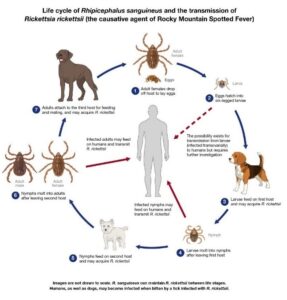
CDC
- The fertilized blood-drinking females leave the host and fall to the ground to lay eggs in cracks in the floors, under breeding and birthing boxes, or in the passages used by domestic animals.
- One female lays 1400-5000 eggs within 9-15 days and then dies.
- The eggs hatch after 15-75 days into larvae that climb the bottom of the walls or furniture and wait for the host to come into contact with it (it may be of the same type as the first host or another type), and they cling to it to suck blood and then leave the host after about 4 days to fall to the ground or cling to the furniture or the walls where they molt and turn into nymphs. These nymphs re-attach to another host that feeds on blood for a period of 3-11 days and then falls to the ground to molt into the adult stage that relates to another host whose blood they feed on for a period of 1-3 weeks, during which the females are fertilized and then leave the host to lay eggs.
- Fertilized larvae and females can wait for the host without feeding for up to 250 days. As for the nymphs, they cannot stay for more than three months.
Damage and Medical Implications
- The brown dog tick parasitizes all types of vertebrate animals, as well as humans and birds.
- The infection of this type is concentrated in the head or the nape and ears and causes severe pain, weakness, and emaciation when infected with dogs and cats.
- High infestation levels can cause skin irritation in dogs.
- The brown dog tick is a vector of several pathogens causing dog diseases including canine ehrlichiosis (Ehrlichia canis) and canine babesiosis (Babesia canis). These rarely cause disease in humans; only a few cases are known.
- In dogs, symptoms of canine ehrlichiosis include lameness, depression, weight loss, anorexia, and fever; for babesiosis symptoms include fever, anorexia, and anemia.
- Rocky Mountain spotted fever, caused by Rickettsia rickettsii, is a severe tick-borne disease in humans. This pathogen was reported to be transmitted by brown dog ticks.
- Camel Tick:
General Description
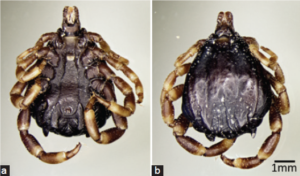
Camel tick Hyalomma dromedarii (Acari: Ixodidae) adult male:
(a) Ventral and (b) dorsal (Credit: Al-Deeb and Bin Muzaffar, Veterinarywork.org)
- The dorsal shield of males can reach a length of 3.7–5.8 mm.
- These hard-bodied ticks are broadly oval in shape.
- The basic color is yellow- to red-brown.
Life Cycle and Common Characteristics
- The camel tick parasitizes mainly camels (that are the main hosts of the adults) but may infect cattle, horses, sheep, goats, dogs, rodents, birds, or humans.
- The fertilized blood-drinking females lay eggs in the cracks of the walls or under the stones in the places where animals are raised.
- One female can lay from 2000-14000 eggs at once, and then it dies.
- The eggs hatch after 15-60 days.
- The camel tick is a two-host tick. The incomplete stages live on the same host, then the blood-sipping nymphs fall off to molt in the soil, then the adult re-attaches to the same host or any other host.
- The larvae that climb grasses or walls, and remain as well, waiting for the body of their preferred host to touch those grasses or walls (it prefers small mammals such as rodents and lizards), attach to it and suck its blood. It molts twice on the same host in a period of 4-8 days, then leaves the host to hide again in the cracks and under the stones, where it molts into a full animal after 15-45 days to re-attach to the preferred host for the full phase (the tick prefers large mammals such as camels, cattle and sheep and may infect humans). It feeds on its blood for a period of 10-15 days, and after being fertilized the female leaves the host to lay eggs.
Damage and Medical Implications
- Camel ticks are blood feeding parasites in all their life stages after the egg and in both sexes (images show infestation of camel ticks on different body parts of the camel)
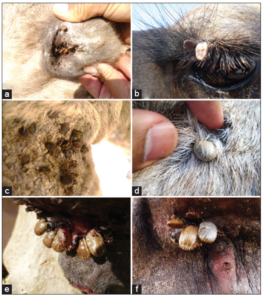
Camel ticks on different body parts of the camel: (a) Ear, (b) upper eyelid, (c) leg, (d) abdomen, and (e and f) tail area (Credit: Al-Deeb and Bin Muzaffar, veterinaryworld.org)
- They are vectors of bacterial, protozoal, rickettsial, spirochaetal, and viral diseases of humans and animals.
- Irritating bites of camel ticks cause severe harm to their hosts due to blood loss, damage to the skin, and anorexia that lead to reduction in Lesions and secondary infections are commonly caused by bites of these ticks.
- Camel ticks are the major vector of theCrimean-Congo hemorrhagic fever virus (CCHFV). The transmission cycles involve different livestock.
- Nymphs feed on birds and small burrowing animals as rodents, but the nymphs can infest large animalslike It commonly behaves as a two-host tick and appears throughout the year. It is found wherever camels live. It has a vital role in the transmission of emerging and re-emerging diseases such as Theileria, Rickettsia, Francisella, Q fever, and other viruses.
II – Soft Ticks Soft ticks differ from hard ticks in the absence of a hard chitinous shield, in addition to the fact that the mouth parts are located on the lower surface of the body and are not seen from above, unlike hard ticks. Males and females are similar in appearance, and when they drink in adult animals, they do not noticeably increase in size. Four genera belong to soft ticks, the most important of which from a health point of view for humans are the genus Orinthodoros which causes the relapsing fever tick, and the genus Argas which causes common fowl tick. Both genera infect humans asymptomatically in the absence of their preferred host. The life cycle differs from that of the hard ticks in the feeding period of different instars and the number of feeding times. The larvae feed for up to 10 days, while the feeding period for nymphs and adults does not exceed half an hour each time. The female feeds several times and lays a few eggs after each time.
- Fowl Tick or Poultry Tick:
General Description
- Fowl ticks are light to dark red-brown (yellowish-brown when starved and slatey-blue when engorged).
- Adults are about 0.5-0.6 mm long.
- Mouthparts in nymphs and adults are not visible when viewed from above since they are hidden by the front margin of the tick’s body.
The skin is wrinkled.
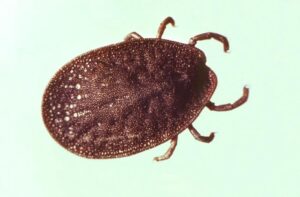
Credit: CDC |

Soft Tick Credit: Navid Drogba |
Life Cycle and Common Characteristics
- Fowl ticks are found on an animal host, in cracks and crevices of buildings or in nests during the day and feed at night.
- These ticks are particularly active in poultry houses during warm, dry weather.
- Mating and laying eggs occur off the host and in sheltered areas such as bird nests.
- Eggs will hatch 10-30 days after being laid, depending on temperature and humidity within their habitat.
- Six-legged larvae hatch from the eggs in the selected sheltered area.
- Larvae begin to feed for a few hours to a few days after selecting the host.
- Larvae can be found on the birds because they remain attached and feed for 2–7 days.
- The larvae finish feeding and leaves the host and find a shelter.
- Nymphs and adults feed at night for 15–30 minutes.
- Nymphs feed and molt several times before reaching the adult stage.
- It has a multihost life cycle. This means that it has two or more nymphal stages that each require a blood meal.
- Adults feed repeatedly, most commonly under the wings, and the females lay from 50 to 500 eggs after each meal when off the hosts.
- Adult females may live more than 4 years without a blood meal.
Damage and Medical Implications
- Fowl ticks are usually associated with poultry production, but roaming ticks can also invade and infest homes and attempt to feed on people and pets.
- Adult and nymph fowl ticks most actively seek to feed at night and feed for only about 15-30 minutes before leaving their host and returning to their harborage site.
- Fowl ticks are carriers of the spirochete bacteria Borrelia anserinawhich causes avian spirochetosis, one of the most severe diseases affecting the poultry industry.
- Fowl tick infestation cause the following:
- Anemia, weight loss, drowsiness, depression, toxemia, and paralysis.
- loss of appetite
- Egg production decreases.
- Red spots can be seen on the skin where the ticks have fed.
- Death is rare, but production may be severely depressed.
- Relapsing Fever Tick:
General Description
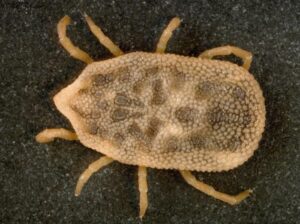
- The adult soft tick has eight legs, rounded body, dimples on their body, and mouthparts hidden from view when seen from above.
Life Cycle and Common Characteristics
- Female ticks lay eggs in batches, with each batch of eggs produced after taking a blood meal.
- A female may lay from 25 to several hundred eggs during her lifetime.
- Relapsing fever ticks go through four developmental stages: eggs, larvae, nymphs and adults.
- They feed for only about 15-30 minutes and then leave the host
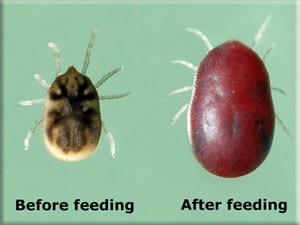
Credit: Gary Hettrick RML, NIAID – CDC
Damage and Medical Implications
- Infected soft ticks in the genus Ornithodoros and Carios transmit tick-borne relapsing fever.
- It is a bacterial infection with symptoms that include repeated episodes of fever, headache, muscle, bleeding, stiff neck, joint aches, nausea and vomiting, weakness, and coma. These symptoms usually continue for 2 to 9 days, then disappear
- The ticks typically prefer to feed on hosts in their nests or burrows.
- The ticks seldom come into contact with people. They emerge at night and feed briefly while the person is sleeping and the bites are painless.
- Infected people develop sickness between 5 and 15 days after they are bitten.

